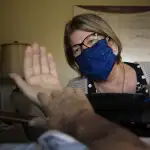When COVID-19 came to New Orleans, Nicole Alston felt the impact immediately.
Alston, 45, is a home care worker who helps clients — often people who are older, or who have disabilities — do things like eat, bathe and get dressed.
As her family’s breadwinner, Alston earns $8.50 per hour. The money’s barely enough. She and her husband are both diabetic. Her 19-year-old daughter, also diabetic, and 16-year-old nephew live at home with her. On weekdays, she takes care of three of her grandchildren.
Before the pandemic, Alston, who works through a home care company, saw five clients regularly and worked 40 hours a week. Now, the only person she cares for is her husband, who is vision-impaired. He has coverage through Medicaid, so the company she works for charges his plan and then pays her.
Her employer recently asked her to take on another client. But though she could use the money, she declined. Because of her family’s medical history — one of her grandchildren also has a heart condition — Alston is terrified of contracting the virus.
“I don’t feel safe going into somebody’s house. We’re so sick already, so I don’t feel good about it at all,” Alston said.
Alston currently pockets wages for 10 hours of work each week. That’s $85 per week, or $340 per month.
“What do you do? You’ve got to risk your life working, or risk your life not working and having the lack of your basic needs, which is food, water, what have you,” she said. “It’s basically damned if you do, damned if you don’t.”
Stories like Alston’s point to what experts say is an invisible crisis, and it’s one they warn will only spiral as the pandemic continues. COVID-19 has had a disproportionate impact on home care workers. It’s a workforce that is 87 percent women, and a majority Black or Latina. About a quarter are immigrants. Some work for small companies, and some work on the less regulated “gray market,” where employers pay them directly out of pocket, and don’t necessarily require the same level of licensing. Even before the pandemic, home care workers received fewer protections and had higher rates of poverty, even though experts predict the need for home care workers will skyrocket in the coming decade.
The rapidly aging population — by 2030, the U.S. Census project older Americans will outnumber kids for the first time in history — has made home care one of the nation’s fastest growing employment sectors, with already about 4.5 million jobs. But on average, workers earn about $12 an hour, and are more likely to rely on public assistance programs to make ends meet. Researchers say those inequities stem back to the Jim Crow era, citing interwoven, entrenched sexism and racism that have historically kept wages lower and exempted workers from many protections like guaranteed overtime pay.
“They are overwhelmingly female. Most of them, a majority of them, are women of color,” said Melinda Abrams, a senior vice president at the New York-based Commonwealth Fund, a health care foundation and research organization, “I don’t think it’s an accident.”
And now home care providers are on the frontlines of a pandemic — required to do “essential” work with little support or protection. Either they are providing care to vulnerable patients, often with limited PPE, or they’re forced to forgo work and income in an effort to avoid the virus.
“It’s a story of a vulnerable workforce caring for a vulnerable population, and what happens in COVID,” said Dr. Madeline Sterling, an assistant professor at Weill Cornell Medical College, and one of the few researchers to study how COVID-19 has affected home care workers. “There needs to be policy changes that better serve them.”
But the nation’s inattention to the home care sector means that the size and scope of the crisis is impossible to gauge. There’s no data tracking how often home care workers have been diagnosed with the virus or on how many have lost work because of COVID-19. But the work they do certainly puts them at higher risk — the little qualitative research that exists suggests a high risk of infection and little institutional support or protection for vulnerable workers.
Between the economic strain and risk of infection, home care workers are likely also facing a mental health burden, experts say. Women are already at greater risk of anxiety and depression, a trend that has been exacerbated by the pandemic, hitting Black and Latina women especially hard. But there’s also no data tracking incidence of either psychological condition amongst home care workers.
“There’s a crisis going on in home care. We just don’t see it,” said Kezia Scales, the director of policy research at PHI, a New York-based advocacy group that studies home care workers and is frequently cited as an authority on the topic.
Still, the home care workforce has received virtually no attention in Washington’s pandemic response.
The home care workforce hasn’t emerged as a major talking point for either campaign, though former Vice President Joe Biden, the Democratic nominee for president, has outlined a strategy for enhancing home care worker protections. This includes higher pay and paid sick leave, as well as endorsing the “Domestic Worker Bill of Rights,” legislation previously put forth by his running mate Sen. Kamala Harris, which would guarantee things like overtime pay and protection from workplace harassment. President Donald Trump — whose administration has previously sparred with home care workers’ unions — has been silent on the issue, and the Department of Health and Human Services didn’t respond to inquiries about whether it has put forth any policies or initiatives to address home care workers’ needs.
For workers, the crisis is emerging in two forms. There are women like Alston, who are afraid to work because of the risk of exposure, even as they don’t have substantial savings to fall back on.
Then there are others who work, they said, because they must. They need the money, or their clients — who, because of American aging demographics, are also more often women — are medically compromised. If they don’t take care of them, it’s unclear who will.
Policies and benefits to protect home care workers, Abrams said, “would by association help older women.” Many don’t have family nearby to care for them, for instance, or require full-time care that relatives aren’t able to give.
“I realized, if I didn’t do it, nobody was going to be there to help them day to day. They depend on us,” said Adara Benjamin, a 26-year-old home care worker in Chicago who is caring for three clients right now. “If I wasn’t here, who would cook? How is she going to eat?”
Even before COVID-19 hit, home care workers had limited on-the-job protections. Paid sick leave isn’t guaranteed, and health care employers — a category that includes home care companies — were exempted from the federal Families First Act’s mandate to provide employees with paid time off if they fell ill. About a quarter of home care workers don’t have health insurance, according to data from 2016, the most recent year for which figures are available. More than a third rely on Medicaid or Medicare for their coverage.
And home care workers fall lower on the federal priority list for high-end PPE, like the protective N95 masks that lower the risks of contracting COVID-19. Some receive gloves and masks from their employers, or from the state or county, but there’s no uniform policy or standard. Even among those who get PPE, many say it’s nowhere near enough. And employers, who themselves have thin profit margins, aren’t reimbursed for PPE they purchase for employees.
Benjamin makes about $14 an hour, and most of that, she said, goes toward buying protective gear. It’s expensive, but she feels she has no choice. Her employers only give her one mask per client every two weeks, and a pair of gloves every two weeks, she said. Sometimes, she needs multiple pairs of gloves in one day.
Benjamin lives with her 49-year-old mother, who works from home and has diabetes and high cholesterol.
“I’m beyond terrified. Petrified. I have no idea — what would I do if at any point in time I contract it?” she said.
Benjamin is still better off than many of her peers: She has health insurance through her union. Workers who are non-unionized, or who work though the less regulated home care “gray market,” often don’t even have that.
Lydia Nakiberu, a 41-year-old worker in Massachusetts, is undocumented. She works in home care, though the pandemic means her work has dipped significantly — from 40 hours a week to 12. Her husband, currently applying for asylum, works in a nursing home. Some of her clients pay her minimum wage, which is $12 per hour in Massachusetts, but others pay less.. Neither Nakiberu nor her husband has health insurance.
When he contracted COVID-19 earlier this year, she cared for him with “home remedies” like Vitamin C and hot water, she said. She knows doing even what little work she has now — caring for one client on weekends, whom she takes the bus to visit — exposes her, too. So she puts whatever money she can toward buying extra protective gear.
“I can’t afford getting sick, because I don’t have health insurance,” Nakiberu said. “I can afford the masks more than I can afford going to the hospital.”
Beyond protective gear, health insurance and sick leave, other inequities further heighten the risk for home care workers, Sterling said. In general, they are much more likely to rely on public transportation, which increases the risk of infection. The pandemic means older clients are more likely to need to stay home. So workers are the ones running errands that take them out of the house and into crowded, indoor spaces — pharmacies and grocery stores, for instance — adding another layer of risk.
Plus, many home care workers don’t get formal training on COVID-19, meaning they’re on their own in deciphering what kind of risk they face and how to navigate it.
All of those are problems that remain unaddressed, Sterling said. And if the pandemic worsens this fall, as expected, they’ll only take on heightened significance — even if the absence of federal or state data makes it impossible to track just how bad things get.
“These are folks who provide personal care, medical care, emotional support,” Sterling said. “Despite being integral, they are often left out of the conversation. A lot of what they do is unrecognized.”





